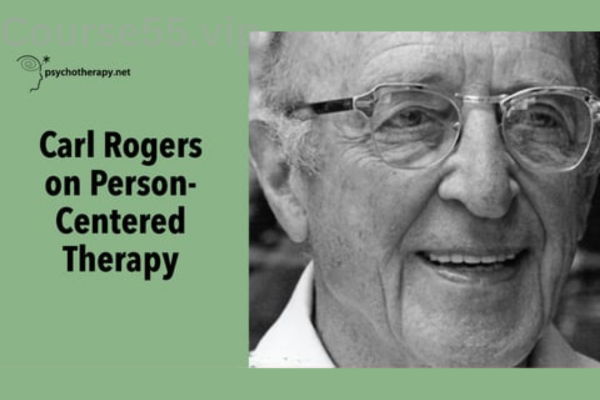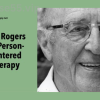Carl Rogers on Person-Centered Therapy With Carl Rogers, Natalie Rogers
$34.00 Original price was: $34.00.$7.70Current price is: $7.70.
Carl Rogers and Person-Centered Therapy: A Comprehensive Review with a Focus on Natalie Rogers – Digital Download!

Carl Rogers on Person-Centered Therapy With Carl Rogers, Natalie Rogers
Overview

Carl Rogers and Person-Centered Therapy: An In-Depth Exploration with Insights from Natalie Rogers
Introduction: Revolutionizing Therapy Through Carl Rogers’ Vision
Carl Rogers stands as one of the most transformative figures in psychology, reshaping therapeutic practices through his creation of person-centered therapy (initially called client-centered therapy). This groundbreaking approach, which took shape in the 1940s, not only altered psychotherapy but also extended its impact into education and organizational development. Rogers’ approach rests on the idea that people inherently have the capacity to understand their own experiences and bring about meaningful changes in their lives. Through a compassionate and nurturing framework, Rogers emphasized the creation of a safe space characterized by unconditional positive regard, empathy, and congruence. He believed that these elements facilitate a safe environment where individuals could openly explore their thoughts and emotions without fear or judgment. In examining Rogers’ legacy, it’s essential to recognize the contributions of his daughter, Natalie Rogers, whose expansion of his principles into expressive arts therapy further enriched his ideas. Together, their work serves as a cornerstone of humanistic psychology, providing a pathway to deep personal transformation.
Core Elements of Person-Centered Therapy
Foundational Components: The Pillars of the Therapeutic Process
At the core of person-centered therapy lies the commitment to three key conditions: unconditional positive regard, empathy, and congruence. These principles are foundational to creating a supportive and transformative environment:
-
Unconditional Positive Regard: This condition is about accepting and valuing the client without judgment. Rogers posited that when individuals are met with consistent warmth and acceptance, they feel safe to explore their thoughts and emotions, setting the stage for personal insight.
-
Empathy: Empathy entails deeply understanding the client’s emotional state and perspective. Through active listening and emotional resonance, therapists help clients feel understood, which encourages self-reflection and awareness.
-
Congruence: Congruence refers to the therapist’s authenticity in the therapeutic relationship. By being genuine, therapists model honest self-expression, cultivating trust and openness, and empowering clients to express their true selves.
Together, these core components foster an environment where clients feel empowered to explore their struggles and embrace self-acceptance, ultimately moving toward greater self-realization and personal growth.
A Non-Directive Approach to Therapy: Empowering Clients
One of the hallmarks of person-centered therapy is its non-directive nature. Unlike traditional therapies, where the therapist often takes an active role in directing the treatment, this model allows clients to lead the therapeutic process. By empowering clients to take the reins in their journey of healing, the approach emphasizes autonomy, self-reliance, and personal accountability.
For example, in a typical session, a client may express a problem or concern. Rather than offering solutions or directing the conversation, the therapist serves as a compassionate guide, encouraging the client to explore their feelings and thoughts. This process often leads clients to recognize that they hold the wisdom to navigate their own challenges.
Research consistently supports the efficacy of this non-directive approach. For instance, a 2007 meta-analysis published in the Journal of Counseling Psychology highlighted that person-centered therapy notably improved clients’ self-esteem and emotional regulation, underscoring the effectiveness of Rogers’ method in facilitating deep personal change.
The Expanding Legacy of Natalie Rogers: Integrating Expressive Arts
Building on a Foundation of Humanistic Psychology
While Carl Rogers established the framework for person-centered therapy, Natalie Rogers enriched and expanded these principles through her work in expressive arts therapy. She believed that creative expression could serve as a powerful tool for healing and self-discovery.
-
Expressive Arts Therapy: Natalie integrated various forms of artistic expression, such as drawing, painting, music, and dance, into the therapeutic process. She recognized that these creative outlets provided clients with a means to articulate emotions that might be difficult to express verbally.
-
Creative Empowerment: Natalie’s work emphasized the innate creativity within every individual, viewing it as a path to self-exploration. In her book The Creative Connection, she explained how artistic expression facilitates communication of complex emotions, unlocking deeper understanding of one’s experiences.
-
Workshops and Training: Beyond individual therapy, Natalie developed training programs for therapists to incorporate expressive arts into their practice. Her workshops created a supportive community of professionals committed to fostering emotional healing through creativity.
Natalie Rogers’ groundbreaking work has expanded person-centered therapy, showcasing how the foundational principles of her father’s approach can be adapted and enhanced through the integration of artistic processes. This blend of humanistic psychology with creative expression offers new avenues for clients to explore and express their inner worlds.
Innovative Approaches: Bridging Traditional Therapy and Creative Expression
Natalie Rogers’ emphasis on expressive arts therapy provides an essential counterbalance to the traditional, verbal-centric nature of psychotherapy. Recognizing that some individuals, especially those with traumatic experiences or marginalized backgrounds, might struggle to communicate their feelings through words, she introduced multisensory therapeutic techniques.
-
Multisensory Engagement: Incorporating various artistic forms allows clients to engage different senses, tapping into emotions that may be difficult to reach with words alone. This multisensory approach fosters deeper emotional experiences and enhances healing by allowing clients to confront and process their feelings holistically.
-
Art as a Catalyst for Transformation: Creative activities can serve as a catalyst for self-reflection. As clients engage in artistic expression, they may uncover emotions or experiences previously hidden beneath the surface, gaining clarity and insight into their challenges.
Through this innovative application of person-centered principles, Natalie Rogers demonstrated how creativity can expand the possibilities of psychological practice, offering clients new pathways to self-understanding and healing.
Research Support and the Effectiveness of Person-Centered Therapy
Proven Benefits in a Range of Clinical Settings
The research supporting the effectiveness of person-centered therapy continues to affirm its value in treating a wide range of psychological conditions. Numerous studies have shown that this approach can be especially effective in addressing issues such as depression, anxiety, and PTSD.
-
Versatility Across Populations: A 2013 study in the American Journal of Psychotherapy revealed that person-centered therapy achieved positive results across a diverse range of clients, including children, adolescents, and older adults. This flexibility highlights the universal applicability of the approach, which values and responds to individual experiences.
-
Sustained Improvements: Longitudinal research has demonstrated that clients who engage in person-centered therapy not only see immediate improvements in symptoms but also experience lasting benefits. A 2019 meta-analysis found that clients who underwent person-centered therapy were significantly more likely to report ongoing life satisfaction long after therapy ended.
Adapting to Contemporary Needs
The adaptability of Rogers’ approach has allowed it to remain relevant in modern psychology. Continued research on the integration of technology, including online counseling platforms, suggests that person-centered therapy continues to evolve while maintaining its core principles.
Applications Beyond Psychotherapy: A Broader Influence
The principles of person-centered therapy have influenced numerous fields, including education, business, and community development. These applications share a commitment to empathy, respect for individual experiences, and collaborative engagement.
-
In Education: Rogers’ approach has been embraced in educational settings, where teachers who create supportive and empathetic learning environments foster both academic and emotional growth in students.
-
In Business and Organizations: Companies have implemented person-centered principles to enhance organizational culture, improve employee well-being, and boost productivity.
-
Community-Based Initiatives: Community programs incorporating person-centered methods have been successful in addressing mental health disparities, offering accessible support to underserved populations and promoting a culture of empathy.
These diverse applications demonstrate the far-reaching impact of person-centered therapy, emphasizing the universal value of creating compassionate, understanding environments.
Conclusion: The Enduring Impact of Carl and Natalie Rogers
Carl Rogers’ development of person-centered therapy has had a profound impact on counseling and psychotherapy, underscoring the transformative potential of the therapeutic relationship and empowering individuals to lead their own growth. His principles of unconditional positive regard, empathy, and congruence continue to guide modern therapeutic practices. Moreover, Natalie Rogers’ contributions through expressive arts therapy have expanded the scope of person-centered approaches, offering new ways for individuals to communicate complex emotions and experiences. The continued success of person-centered therapy in various contexts reaffirms its importance in contemporary psychology. By incorporating these principles into therapeutic, educational, and organizational spaces, Carl and Natalie Rogers’ legacy offers a path toward deeper understanding, emotional healing, and personal growth for individuals across all walks of life.
Frequently Asked Questions:
Business Model Innovation: We operate a group buying strategy, allowing participants to share costs and access popular courses at reduced prices. This model benefits individuals with limited financial resources, despite concerns from content creators about distribution methods.
Legal Considerations: The legality of our operations involves complex issues. Although we don’t have explicit permission from course creators to resell their content, there are no specific resale restrictions stated at the time of purchase. This ambiguity creates an opportunity for us to provide affordable educational resources.
Quality Control: We ensure that all course materials purchased are identical to those offered directly by the creators. However, it’s important to understand that we are not official providers. As such, our offerings do not include:
– Live coaching calls or sessions with the course author.
– Access to exclusive author-controlled groups or portals.
– Membership in private forums.
– Direct email support from the author or their team.
We aim to reduce the cost barrier in education by offering these courses independently, without the premium services available through official channels. We appreciate your understanding of our unique approach.
Be the first to review “Carl Rogers on Person-Centered Therapy With Carl Rogers, Natalie Rogers” Cancel reply
You must be logged in to post a review.

 The Essential Guide To Acupressure By Paige Bourassa
The Essential Guide To Acupressure By Paige Bourassa  The Legacy of Unresolved Loss: A Family Systems Approach with Monica McGoldrick
The Legacy of Unresolved Loss: A Family Systems Approach with Monica McGoldrick 















Reviews
There are no reviews yet.